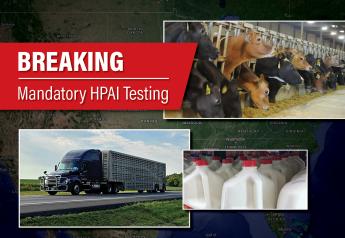High Beef Prices Make Great Time to Own Cattle

By: Duane Dailey, University of Missouri Extension
"With record high beef prices, it’s a great time to be in the cattle business," Scott Brown told a meeting of Miller County, Mo., producers.
The University of Missouri beef economist’s outlook shows a $250 return per cow in the coming year. In the previous beef cycle, returns topped at under $100 per cow.
"We’ve never seen anything like current prices," Brown said.
Then he showed price projections from the Livestock Market Information Center. Their cow-calf returns show $350 for 2014—and 2015. Those returns are over cash cost plus pasture rent.
"Before you go home and double the size of your cow herd, remember the cattle cycle," Brown said. When cow numbers go down, prices go up. However, when numbers go up, prices go down.
The Jan. 1 cow count shows the U.S. herd declined to 87.7 million cattle. Go back to the 1950s, when prices were high, for the previous low of just over 90 million head.
"While supply is short, prices look good for the next few years." Brown said. "While those outlooks are great, there are always risks."
Weather can change. Domestic demand for beef can continue down. Thriving exports can end. "It happened with the ‘mad cow,’ or BSE, in 2001."
The beef cow herd will expand, Brown said. "We’re at a turning point. With this much money on the table, we will add more cows."
He reminded the 50 producers of an old saying: "The best cure for high prices is high prices."
"To remain in the industry long term, you must be efficient," Brown said. Least-cost production makes a difference. And every farm needs a risk strategy.
One thing making economics brighter for cattle producers is a change in the price of corn, a major feed for market cattle. "Corn at $4.50 per bushel looks better than corn at $7.50.
"Recall, we didn’t think $4.50 corn looked so good on the way up."
However, continued high-price soybeans and soybean meal tell a different story. Cattle don’t eat much soybean meal. Hogs and poultry do. "High-priced soybeans may dampen increases of pork and chicken," Brown says.
In past cycles, white meats replaced beef at the grocery case, but times change. More meat is eaten in restaurants today.
"In Iberia, home-cooked meals are usual. On both coasts, more food dollars are spent in restaurants than grocery stores. In restaurants, beef still brings top dollar."
Domestic consumption of all meats remains a concern. Meat sales have been in steady decline since early in the recession. The decline starting in 2007 just now starts back up as the economy recovers, Brown says.
Export demand booms. "And overseas sales will be huge if China opens its doors to U.S. beef." China has a large population and an economy growing 5 to 7 percent per year. U.S. economic growth stays under 2.5 percent.
As more people join China’s growing middle class, they will want more beef, Brown said.
"While export is important, domestic consumption remains your main market," Brown told producers. Big importers of U.S. beef are our neighbors, Mexico and Canada.
"We favor free trade as long as we can sell anywhere we want, but keep foreign meat out," Brown said. "That can backfire."
After his optimistic outlook, Brown reminded producers of risks.
"The time to expand may be now," he said. But breeding cattle and building herds take time.
"Calves from cows bred this spring will go to market a long time from now. By then prices can be in decline."
His slide of the cattle cycle of the future showed a smoother decline than past cycles. The biggest risks are disease outbreaks and weather’s impact on crops and forages.
"Every farm differs in terms of risk," he said. "In high-cost times, everyone needs a risk plan."
Brown is from the agricultural and applied economics unit at the MU College of Agriculture, Food and Natural Resources. He spoke at a chili supper held by the First State Bank of Iberia.







